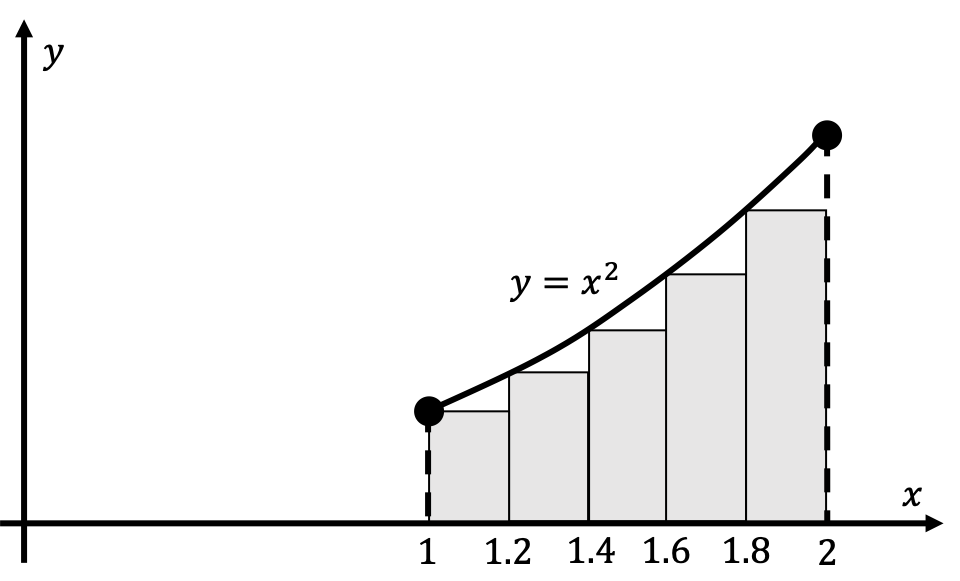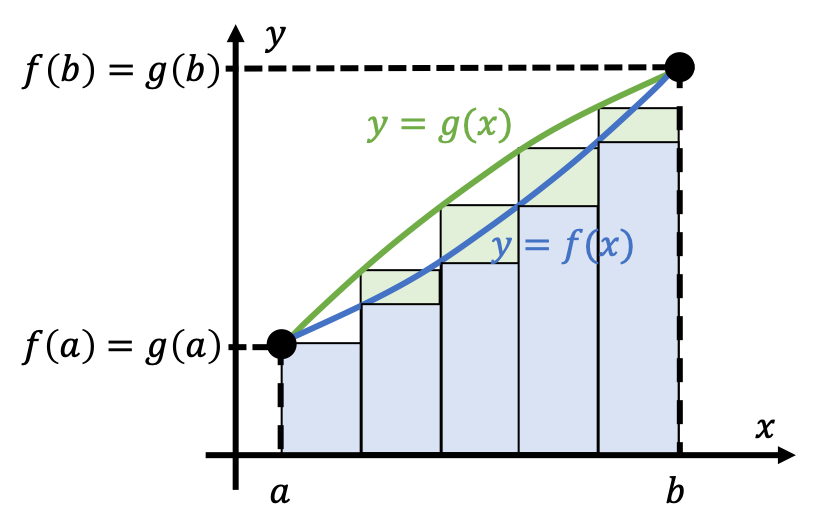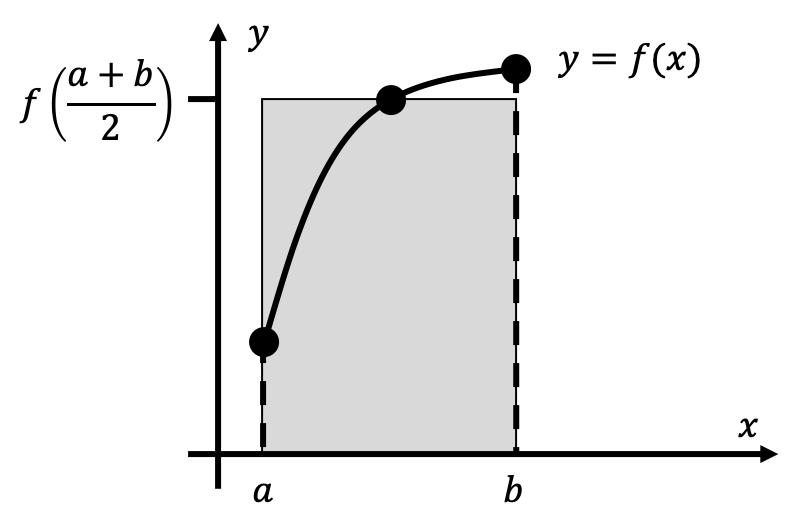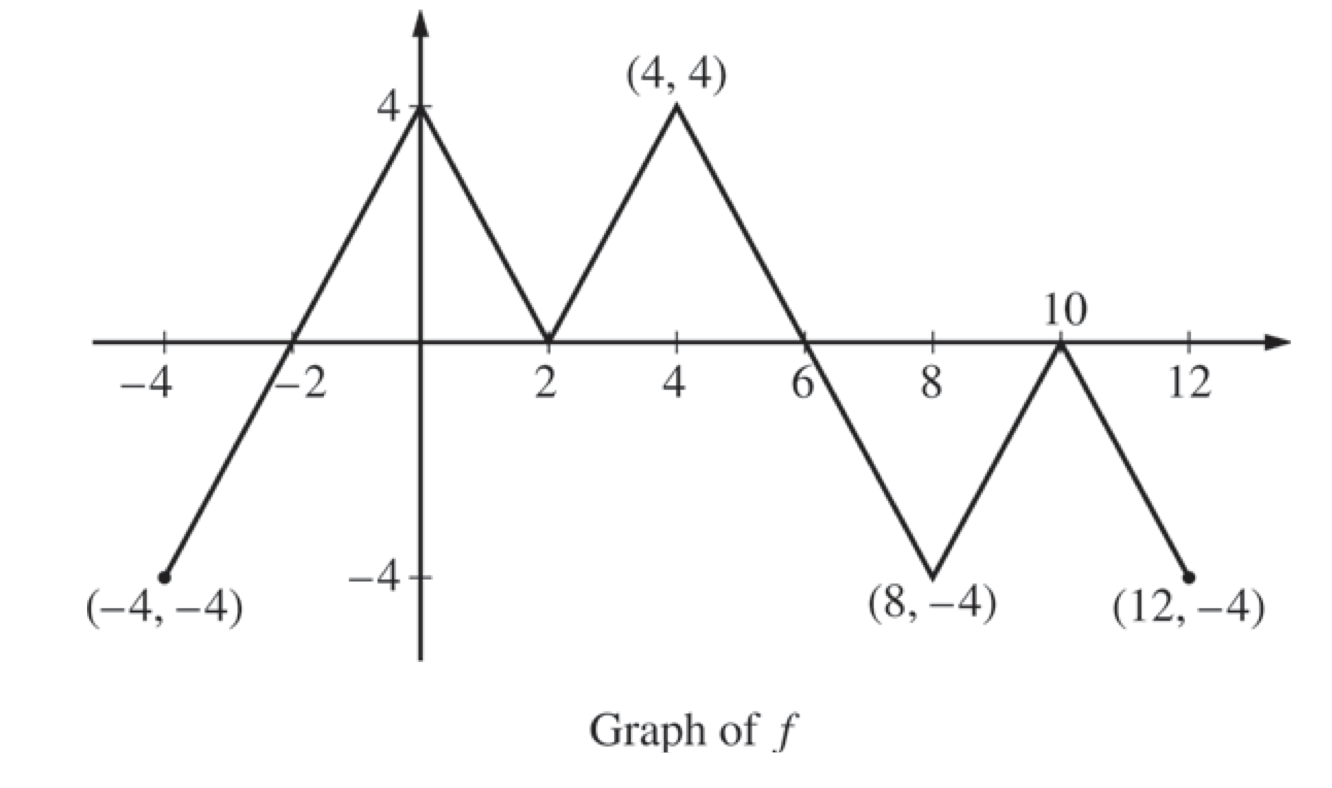Integration Practice Problems, Part 1 (Solutions)
The following solutions are for the integration practice problems linked here. I encourage you to attempt them by yourself first before looking through the solutions.
Original problems statements are highlighted in blue. Final answers are highlighted in green. Follow-up extension questions are highlighted in orange.
Practice Problem Solutions
Problem 1
Which of the following statement(s) are true?
1. If $f(x)$ is increasing and concave up on $[a, b]$, then the left Riemann sum for $\int_a^b f(x)dx$ is an underestimate.
2. If $f(x)$ is concave up on $[a, b]$, $g(x)$ is concave down on $[a, b]$, $f(a)=g(a)$, $f(b)=g(b)$, and $f(a)<f(b)$, then the left Riemann sum for $\int_a^b f(x)dx$ is less than the corresponding left Riemann sum for $\int_a^b g(x)dx$.
3. If $f(x)$ is concave down on $[a, b]$, then the midpoint Riemann sum for $\int_a^b f(x)dx$ is an overestimate.
We are asked to evaluate the validity of fairly general statements about integral calculus. In problems like this, it is always easiest to consider a well-defined case that you’re familiar that satisfies the conditions of the problems, and evaluate whether the statement is true or false.
For statement 1, let’s sketch an arbitrary function $f(x)$ that is increasing and concave up. One example could be the function $f(x)=x^2$ with $a=1$ and $b=2$:

As we can see, a left Riemann sum with arbitrarily chosen $n=5$ rectangles does indeed underestimate the area under the curve, as there is a lot of white space under the curve that is unaccounted for by the rectangles. From considering this particular concrete example, we can conclude that statement 1 is true.
For statement 2, let’s again sketch an concrete set of functions $f(x)$ and $g(x)$ that satisfy the conditions posed in this problem:

Indeed, we can see that for this particular case, the blue rectangles that compose the Riemann sum for $f(x)$ always have an area less than or equal to the corresponding set of green rectangles that compose the Riemann sum for $g(x)$. Therefore, we can conclude from this representative diagram that statement 2 is true.
For statement 3, we can sketch a convex function $f(x)$ and the corresponding midpoint Riemann sum with $n=1$ rectangles in order to make our diagram clear:

From this diagram, it is clear that the gray area above the curve $f(x)$ is significantly greater than the small white space unaccounted for by the Riemann sum underneath the curve $f(x)$. From this example, it is clear that the midpoint Riemann sum for the integral $\int_a^b f(x)dx$ is an overestimate, meaning that statement 3 is true.
Statements 1, 2, and 3 are all true.
Problem 2
For the function whose values are given in the table below, $\int_0^6 f(x) dx$ is approximated by a Riemann Sum using the value at the midpoint of each of three intervals of width $2$. What is the value of the approximation?
| $x$ | 0 | 1 | 2 | 3 | 4 | 5 | 6 |
| $f(x)$ | 0 | 0.25 | 0.48 | 0.68 | 0.84 | 0.95 | 1 |
Using the midpoint Riemann sum formula from our previous work, we can approximate the integral expression as
\[\int_0^6 f(x)dx\approx (2-0)f\left(\frac{0+2}{2}\right)+(4-2)f\left(\frac{2+4}{2}\right)+(6-4)f\left(\frac{4+6}{2}\right)\]Simplifying this expression and using the data given in the table gives us
\[\int_0^6 f(x)dx \approx 2f(1)+2f(3)+2f(5)=2(0.25+0.68+0.95)=3.76\]Therefore, our solution is
$$\int_0^6 f(x)dx \approx 3.76\text{ sq. units}$$
Problem 3
The table below gives values of a decreasing, differentiable function $f(x)$. Approximate the value of $\int_0^8 f(x)dx$ using a trapezoidal sum with four subintervals indicated by the data in the table.
| $x$ | 0 | 1 | 5 | 6 | 8 |
| $f(x)$ | 20 | 16 | 8 | 6 | 2 |
Using the trapezoidal Riemann sum formula from our previous work, we can approximate the integral expression as
\[\int_0^8 f(x)dx\approx \frac{1-0}{2}[f(0)+f(1)]+\frac{5-1}{2}[f(1)+f(5)]+\frac{6-5}{2}[f(5)+f(6)]+\frac{8-6}{2}[f(6)+f(8)]\]Simplifying this expression and using the data given in the table gives us
\[\int_0^8 f(x)dx\approx \frac{20+16}{2}+2(16+8)+\frac{8+6}{2}+(6+2)\]Simplifying our approximation gives
$$\int_0^8 f(x)dx \approx 81\text{ sq. units}$$
Problem 4
If $\int_2^8 f(x) dx = -10$ and $\int_2^4 f(x)dx = 6$, what is the value of $\int_8^4 f(x)dx$?
This problem is simply testing your understanding of integral properties. Referencing property 2 on the linked page, we can conclude that
\[\int_2^8 f(x) dx=\int_2^4 f(x) dx+\int_4^8 f(x) dx\]Plugging in the given values gives
\[-10=6+\int_4^8 f(x) dx \longrightarrow \int_4^8 f(x) dx = -16\]Finally, referencing property 1 on the linked page gives
$$\int_8^4 f(x) dx=-\int_4^8 f(x) dx = 16$$
Problem 5
Evaluate the indefinite integral $$\int (x+3)\sqrt{x-1}dx$$
This is a problem that requires you to use the $u$-substitution integration technique. If you are unfamiliar with $u$-substitution, I encourage you to first review the relevant material here.
Set $u=x-1$. If we add $4$ to both sides of this equation, then we find that $x+3=u+4$. We also know from this definition of $u$ that $\frac{du}{dx}=1$, meaning that $du=dx$. Using all of this information together, we can rewrite the integral as
\[\int (x+3)\sqrt{x-1}dx=\int (u+4)\sqrt{u}du=\int u^{3/2} du+4\int u^{1/2} du\]We have used the linearity property of integration to separate this integral into two simply integrals. Using the power rule for integration, we find
\[\int (x+3)\sqrt{x-1}dx=\frac{2}{5}u^{5/2}+\frac{8}{3}u^{3/2}+C\]for some constant $C$. Plugging the definition of $u=x-1$ back into the right hand side gives us our solution.
$$\int (x+3)\sqrt{x-1}dx=\frac{2}{5}(x-1)^{5/2}+\frac{8}{3}(x-1)^{3/2}+C$$
Problem 6
Evaluate the indefinite integral $$\int \frac{dx}{e^x+1}$$
This is a problem that requires you to use the $u$-substitution integration technique. If you are unfamiliar with $u$-substitution, I encourage you to first review the relevant material here.
Perhaps our first guess might be to define $u=e^x+1$ or $u=e^x$. However, in both of these cases, $\frac{du}{dx}=e^x$, and so $du=e^x dx$. We are missing the $e^x$ factor in the numerator, and so it ostensibly appears as if this integral is not able to be solved.
The trick is to rewrite this integral into a form that we can evaluate. Although it might not be apparent at first, let’s multiply both the numerator and denominator by $e^{-x}$. Because this is essentially equivalent to multiplying the fraction by $1$, we are not changing the value of the integral in this process.
\[\int \frac{dx}{e^x+1}=\int \frac{dx}{e^x+1}\frac{e^{-x}}{e^{-x}}=\int \frac{e^{-x}dx}{1+e^{-x}}\]At this point we are able to set $u=1+e^{-x}$, therefore giving us $\frac{du}{dx}=-e^{-x}$, or $-du=e^{-x}dx$. Substituting all of these into the integral above gives
\[\int \frac{dx}{e^x+1}=-\int \frac{du}{u}\]We have not discussed how to evaluate this integral yet; the power rule for integration is not applicable here because the power rule doesn’t work when $n=-1$. so I am just going to tell you now that $\int\frac{du}{u}=\ln\vert u\vert+C$. We will derive this result later, but as a high-level overview, this is related to the fact that $\frac{d}{dx}[\ln x]=\frac{1}{x}$ from our work on derivatives. Therefore, using this result, we have
\[\int \frac{dx}{e^x+1}=-\ln \vert u\vert +C=-\ln\vert 1+e^{-x}\vert + C\]after substituting our expression for $u$ in terms of $x$ from above. Now, we note that $e^{-x}>0$ for all $x$, meaning that $1+e^{-x}>0$ always, and so we can get rid of the absolute value signs to give
$$\int \frac{dx}{e^x+1}=-\ln\left( 1+e^{-x}\right) + C$$
There is also another way of approaching this problem as well that is worth discussing. Instead of multiplying both the numerator and denominator by $e^{-x}$, we could also make the (rather clever) observation that $1=(e^x+1)-e^x$. Therefore, we can instead rewrite the initial integral as
\[\int \frac{dx}{e^x+1}=\int \frac{(e^x+1)-e^x}{e^x+1}dx=\int \frac{e^x+1}{e^x+1}dx-\frac{e^x}{e^x+1}dx\]Further simplifying, we have
\[\int \frac{dx}{e^x+1}=\int dx-\int \frac{e^x dx}{e^x+1}\]To simplify the second integral, we can now use $u$-substitution, defining $u=e^x+1$, and hence $du=e^xdx$. Therefore, we have
\[\int \frac{dx}{e^x+1}=\int dx-\int \frac{du}{u}=x-\ln \vert u\vert+C\]Substituting back our definition of $u$ gives
\[\int \frac{dx}{e^x+1}=x-\ln(1+e^x)+C\]Problem: Show that this result is equal to our initial expression we found for the integral using the first method in this problem.
Problem 7
Evaluate the indefinite integral $$\int \frac{\ln(\ln x)}{x\ln x} dx$$
This is a problem that requires you to use the $u$-substitution integration technique. If you are unfamiliar with $u$-substitution, I encourage you to first review the relevant material here.
Set $u=\ln x$, such that $\frac{du}{dx}=\frac{1}{x}$ and therefore $du=\frac{1}{x}dx$. Plugging these defined variables into the integral gives
\[\int \frac{\ln(\ln x)}{x\ln x} dx=\int \frac{\ln u}{u} du\]At this step, we can actually do another substitution by defining $w=\ln u$, such that $\frac{dw}{du}=\frac{1}{u}du$, and hence $dw=\frac{1}{u}du$. Therefore, the indefinite integral can be further rewritten as
\[\int \frac{\ln(\ln x)}{x\ln x} dx=\int \frac{\ln u}{u} du=\int wdw\]Using the power rule for integration,
\[\int \frac{\ln(\ln x)}{x\ln x} dx=\frac{1}{2}w^2+C\]Now, we have to “undo” all of our substitutions. Since $w=\ln u$, we have
\[\int \frac{\ln(\ln x)}{x\ln x} dx=\frac{1}{2}\ln^2 (u)+C\]Since $u=\ln x$, we have
$$\int \frac{\ln(\ln x)}{x\ln x} dx=\frac{1}{2}\ln^2 (\ln x)+C$$
This problem illustrates a variation on the standard $u$-substitution technique. You might have to make multiple substitutions in order to get the integral into an evaluable form. In this particular case, we had to define two different substitutions: $u=\ln x$ and then $w= \ln u$. In general, for most problems on the AP Calculus AB and BC tests, you will not have to make more than two substitutions for a single problem.
Problem 8

The figure above shows the graph of the piecewise-linear function $f$. For $-4\leq x\leq 12$, the function $g$ is defined by $g(x)=\int_2^x f(t)dt$.
1. Does $g$ have a relative minimum, a relative maximum, or neither at $x=10$? Justify your answer.
2. Does the graph of $g$ have a point of inflection at $x=4$? Justify your answer.
3. Find the absolute minimum value and the absolute maximum value of $g$ on the interval $-4\leq x\leq 12$. Justify your answers.
4. For $-4\leq x\leq 12$, find all intervals for which $g(x)\leq 0$.
The official AP scoring rubric for this problem can be found on page 4 of this document. This was Question 3 of the 2016 AP Calculus AB FRQs.